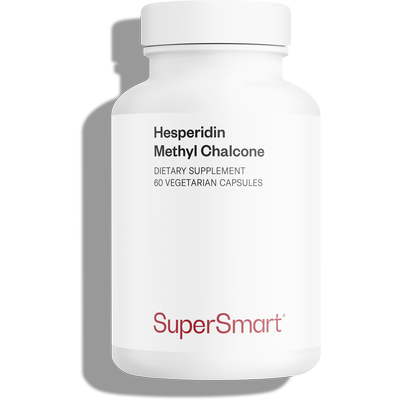31-05-2017
Cardiovascular health: the natural benefits of hesperidin
 Though you may not know hesperidin by name, you have almost certainly consumed this natural substance as it is found primarily in citrus fruits. Hesperidin has been attracting scientific interest for some time because of its positive effects on human health. In particular, researchers have confirmed its benefits for the cardiovascular system, both in terms of circulation and healthy heart function. This is why hesperidin is now being used to prevent and treat cardiovascular problems. Let’s take a look at the latest findings on this natural active principle.
Though you may not know hesperidin by name, you have almost certainly consumed this natural substance as it is found primarily in citrus fruits. Hesperidin has been attracting scientific interest for some time because of its positive effects on human health. In particular, researchers have confirmed its benefits for the cardiovascular system, both in terms of circulation and healthy heart function. This is why hesperidin is now being used to prevent and treat cardiovascular problems. Let’s take a look at the latest findings on this natural active principle.
Beneficial effect of hesperidin on endothelial function
In 2011, the results of two studies conducted by an Italian research team on the therapeutic potential of hesperidin were published in The Journal of Clinical Endocrinology & Metabolism1.
Beneficial effects of supplementing with hesperidin
The researchers monitored the effects of hesperidin supplementation in 24 patients with metabolic syndrome for a period of three weeks. Subjects were divided into two groups, one receiving 500 mg/day of hesperidin, and the other a placebo. Positive effects on endothelial function were observed in the hesperidin-supplemented group. Compared with placebo, the supplements were found to have increased dilation of the brachial artery, suggesting that hesperidin has a vasodilatory effect which could benefit the cardiovascular system, particularly in the case of hypertension. The hesperidin-based treatment also reduced circulating markers of inflammation, marking out hesperidin as a potential therapeutic option.
Specific effect on endothelial cells
In parallel, the Italian scientists investigated hesperidin’s mechanisms of action, by evaluating the activity of a hesperidin metabolite called hesperetin in a bovine aortic endothelial cell culture. Their research showed that hesperetin stimulates activity of endothelial nitric oxide synthase, an enzyme involved in the synthesis of nitric oxide by endothelial cells. This explains hesperidin’s beneficial effects since nitric oxide is involved in numerous biological functions. It has a mainly vasodilatory role which may account for the blood vessel dilation seen during supplementation with hesperidin. In addition, the hesperetin-based treatment produced an increase in the adhesion of certain immune cells in bovine aortic endothelial cells.
Cardio-protective effect of hesperidin
In addition to its benefits for endothelial function, hesperidin also has cardio-protective effects as a result of its antioxidant potency and lipid-lowering properties, according to two studies conducted by Indian researchers. 2,3.
Antioxidant activity for protecting the heart
The two scientists presented the results of their research into the antioxidant potency of hesperidin² in 2010. Convinced of hesperidin’s therapeutic potential, they wanted to evaluate the efficacy of supplementing with this natural substance in protecting against cardiovascular events such as myocardial infarction. They induced myocardial ischaemia in rats by injecting them with isoproterenol, leaving one group of rats as controls. Some of the injected rats were then given hesperidin-based treatment at various dosages: 100mg, 200mg or 400mg/kg bodyweight. Using various analytical measures, they confirmed the relevance of their study by first observing elevated levels of various cardiac markers in the isoproterenol-injected rats, demonstrating the presence of myocardial ischaemia. They noted that these levels were reduced in the hesperidin-treated rats, confirming the potential of this molecule for preventing certain cardiovascular problems.
Expanding their understanding of this molecule’s cardio-protective effects, the researchers subsequently observed that parameters negatively affected by the induced ischaemia reverted to normal levels following the hesperidin treatment. In ischaemic rats, for example, lipid peroxidation markers were raised in the plasma and heart, and antioxidants such as vitamins E and C were reduced, along with activity of enzymes such as glutathione peroxidase and superoxide dismutase. These observations suggest that hesperidin’s cardio-protective effects may be linked to its antioxidant potency and benefits against lipid peroxidation.
Improved lipid profile due to lipid-lowering properties
These same Indian scientists published the results of further research in 2012 in the specialist journal Experimental and Toxicologic Pathology3. In this study, they evaluated how hesperidin’s effect on the lipid profile may also offer cardio-protective benefits. As with their original study, they first induced myocardial ischaemia in several groups of rats, and then administered oral hesperidin to selected groups of animals. Measuring several parameters, they found major changes in the lipid profile of the non-supplemented ischaemic rats:
-
- increased levels of cholesterol, ‘bad’ LDL-cholesterol, VLDL-cholesterol, triglycerides and free fatty acids in plasma;
- decreased levels of ‘good’ HDL-cholesterol in plasma;
- increased levels of cholesterol, triglycerides and free fatty acids in cardiac and hepatic tissue.
These studies have demonstrated the therapeutic potential of hesperidin such that it is now included in the formulation of certain medicines and nutritional supplements. However, bioavailability of this molecule can be sub-optimal which is why it is better to use a methylated derivative of hesperidin which is more easily absorbed in the gastro-intestinal tract.
> Sources :
1. Rizza S, Citrus polyphenol hesperidin stimulates production of nitric oxide in endothelial cells while improving endothelial function and reducing inflammatory markers in patients with metabolic syndrome, J Clin Endocrinol Metab, 2011 May, 96(5):E782-92.
2. Selvaraj P, Pugalendi KV, Hesperidin, a flavanone glycoside, on lipid peroxidation and antioxidant status in experimental myocardial ischemic rats, Redox Rep, Volume 15, 2010 - Issue 5, Pages 217-223.
3. Selvaraj P, Pugalendi KV, Efficacy of hesperidin on plasma, heart and liver tissue lipids in rats subjected to isoproterenol-induced cardiotoxicity, Exp Toxicol Pathol, 2012 Jul, 64(5):449-52.
Order the nutrient mentioned in this article
Further reading
07-06-2016
Imagine a nutrient that could prevent wrinkles, slackening and ageing of the skin, not just on the face (eyelids, cheeks, lips) but also on the...
Read more22-05-2017
An Indian research team has just made a surprising discovery in relation to the accumulation of ‘bad’ cholesterol in the arteries 1 ; a combination...
Read more04-09-2019
A study published in Hypertension , the journal of the American Heart Association, has provided new evidence of this dietary supplement’s effectiveness for reducing the...
Read more© 1997-2025 Fondation pour le Libre Choix
All rights reserved
All rights reserved
Free
Thank you for visiting our site. Before you go
REGISTER WITHClub SuperSmart
And take advantage
of exclusive benefits:
of exclusive benefits:
- Free: our weekly science-based newsletter "Nutranews"
- Special offers for club members only


















